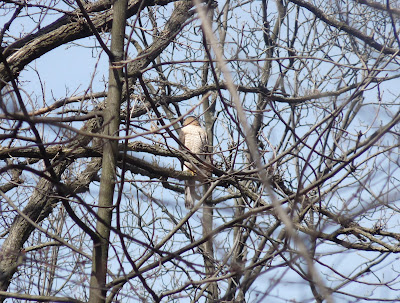Yesterday, I went for a walk with the
Naturalized Habitat Network to
Devonwood Conservation Area in Windsor. It was a beautiful, sunny day with above normal temperatures. Windsor hit 16 degrees Celcius! Devonwood is a small conservation area surrounded by development. It is home to 8 species of oaks (red, white, black, swamp white, chinquapin, pin, shumard and burr), including some very large Shumard oaks.
Shumard oak (
Quercus shumardii) is a member of the red oak group, preferring low, wet, poorly drained clay sites. It often has buttressed roots and may grow to 30m in Ontario
1. The bark is grey-brown, and appeared smoother than other oaks.
 |
| Shumard oak bark |
|
The Pin oak (
Quercus palustris) also prefers wet soil. Pin oak is recognizable by the tendency for lower branches arch downwards. These branches die and eventually fall off, leaving "pins" attached to the trunk
1.
 |
| Pin Oak |
|
This next picture shows the pale grey, fissured bark of a mature white oak, one of my favourite trees. White oak (
Quercus alba) prefers drier sites where the soil has better drainage. This tree at Devonwood is located on an area of slightly higher ground just next to the trail.
White oak can be identified by the massive branches spreading from a short trunk.
White oak wood is very strong and resistant to rot. It was used in barn construction, and for the mast of tall ships (similar to white pine)
1,
2. Rum, whisky, and Louisiana Tabasco sauce are aged in white oak barrels
2! This beautiful tree species can live for 500-600 years
1.
Finally, Burr oak (
Quercus macrocarpa) can also tolerate the seasonal flooding that is so common in the woods of Essex County. The bark is deeply furrowed.
I definitely want to go back to Devonwood once the trees start to flower!
References:
1. Waldron, G. (2003). Trees of the carolinian forest: a guide to species, their ecology and uses. Ontario. Boston Mills Press.
2. Blouin, G. (2001). An eclectic guide to trees east of the rockies. Ontario. Boston Mills Press.










